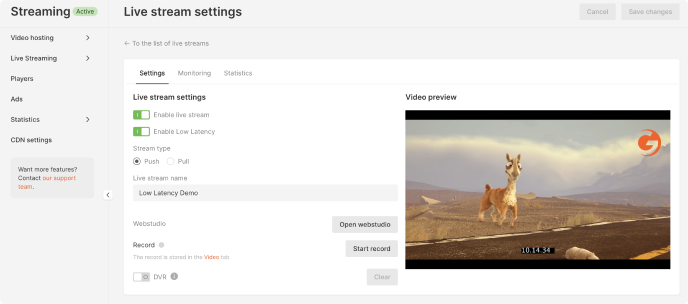Key Benefits
Streaming to a million end-users
Powerful Intel™ hardware and a finely tuned delivery scheme provide enough bandwidth to keep millions of people watching live streams in high quality with low latency.
Minor delay for viewers
LL HLS and WebRTC allow sending and receiving live streams with minimal delay of 1–4 seconds from what is happening in virtual reality to the viewer.
Fast video delivery anywhere in the world
Global Content Delivery Network (210 PoPs on 6 continents) guarantees high delivery speed even to remote regions.
Easy integration & configuration options
User-friendly UI for flexible configuration of your streams. Built-in player for easy integration into any application.
Why does your Metaverse<br>need a Streaming Solution?
Our infrastructure allows broadcasting Metaverse live events to a broad audience, ensuring high performance. The number of active Metaverse participants with VR equipment is growing (Fig. 1), but you can expand it even more with people who consume video content from conventional devices (Fig. 2). There’ll be 300 times more passive observers in 2023 than active participants: 5.7 billion vs. 410 million.




Connect the virtual world with regular viewers via broadcasts. With our Streaming platform, you can broadcast Metaverse events to mobile devices and PCs and expand the target audience.
Use cases

Virtual Entertainment
Organize competitive games in the Metaverse and broadcast a virtual championship for customers.

Sports Media
Increase viewers’ engagement by broadcasting sports events through the eyes of real players.

Online Education
Carry out workshops in the Metaverse, integrate them with real speakers, or broadcast them to the scientific community outside.

Enterprise
Hold meetings with immersive digital avatars of the company’s top leaders to improve the sense of presence and broadcast it to remote employees.
Why does Gcore’s solution suit your<br>Metaverse?
Fast
1–4 seconds delay for end-users
Large-scale
Over 100,000,000 viewers worldwide
Accessible
Global delivery network with over 210 PoPs
Integratable
Player and API for embedding into any app
We’ve been delivering video content since 2018, constantly refining our features to give our clients the best performance.
Fast playback after the stream starts
(7 seconds)
There are several processing steps between starting a video stream and playback. Streaming services need to convert the initial video stream to:
We’ve compressed the processing time and saved up to 50%. The total delay takes 7 seconds. It’s faster than many popular services have.
| Action | Gcore | YouTube | Cloudflare | MUX |
|---|---|---|---|---|
| Start stream | 00:00:00 | 00:00:00 | 00:00:00 | 00:00:00 |
| Notification about the stream start | 00:00:01 | 00:00:06 | 00:00:02 | 00:00:02 |
| Receiving a stream, defining parameters, initializing transcoding | 00:00:02 | No data | No data | No data |
| Transcoding | 00:00:03 | No data | No data | No data |
| Publishing segments | 00:00:05 | No data | No data | No data |
| Loading playlist, buffeering segments, starting playback | 00:00:07 | 00:00:10 | 00:00:10 | 00:00:16 |
| Total delay from the start of the stream to playback in the player | 7 seconds | 10 seconds | 10 seconds | 16 seconds |
Minor delay for the stream viewers
(1–4 seconds)
There are several types of low latency:
We support Low Latency because this technology provides important advantages to our infrastructure and clients:




Size reduction without loss
of quality.
30% less and cheaper
We combine several compression standards: H.264 AVC, H.265 HEVC, and VP9. This allows us to reduce the size of the video stream by an average of 30% without abrupt loss of quality.
That’s how your viewers receive a good-quality picture, even if they have a poor internet connection. And you, in turn, will pay less for the traffic because of the smaller video size.

High bandwidth.
4 times the number of simultaneous viewers
Delivery of video streams is accompanied by intensive traffic. A large number of viewers watching different broadcasts simultaneously in high quality can overload the bandwidth. To avoid this issue, we decided to infix our network of CDN servers with additional precaching servers.
Our Streaming Infrastructure allows us to handle 4 times more user requests (6.6÷1.6), avoid the local bandwidth bottleneck, and improve overall connectivity.
Without Streaming Infrastructure
Direct connectivity (without additional pre-caching servers). Bandwidth is 10 Gbps, or 1.6 thousand viewers who watch broadcasts in high-quality (6 Mbps).

With Streaming Infrastructure
Distributed connectivity (with an additional level of precaching servers). Bandwidth is 30-40 Gbps, or 6.6 thousand viewers who watch broadcasts in high quality (6 Mbps).

User-friendly interface and built-in tools for integration
With Gcore, you can spend your time on business tasks instead of hunting down the technical niceties of the streaming solution.

